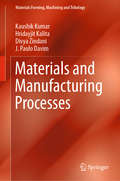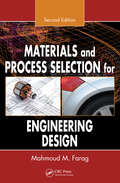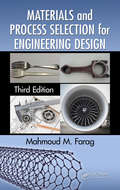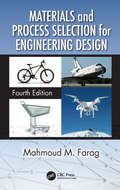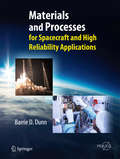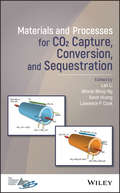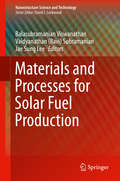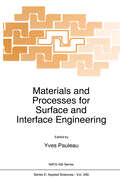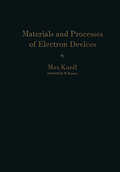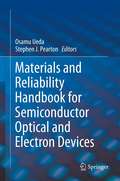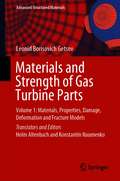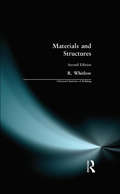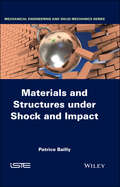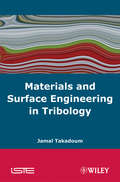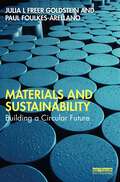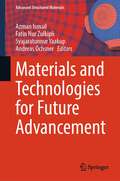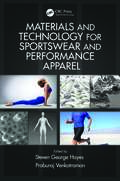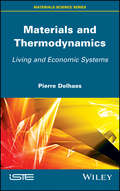- Table View
- List View
Materials and Manufacturing Processes (Materials Forming, Machining and Tribology #86)
by Kaushik Kumar Hridayjit Kalita Divya Zindani J. Paulo DavimThis book introduces the materials and traditional processes involved in the manufacturing industry. It discusses the properties and application of different engineering materials as well as the performance of failure tests. The book lists both destructible and non-destructible processes in detail. The design associated with each manufacturing processes, such Casting, Forming, Welding and Machining, are also covered.
Materials and Process Selection for Engineering Design
by Mahmoud M. FaragTaking a practical approach, this work illustrates how design, materials, and process selection must mesh together and be considered along with economic and environmental analysis, when developing a new product or changing an existing model. It also considers the trade-offs that must sometimes be made. This second edition adds and revises topics
Materials and Process Selection for Engineering Design
by Mahmoud M. FaragIntroducing a new engineering product or changing an existing model involves making designs, reaching economic decisions, selecting materials, choosing manufacturing processes, and assessing its environmental impact. These activities are interdependent and should not be performed in isolation from each other. This is because the materials and proce
Materials and Process Selection for Engineering Design
by Mahmoud M. FaragIntroducing a new engineering product or changing an existing model involves developing designs, reaching economic decisions, selecting materials, choosing manufacturing processes, and assessing environmental impact. These activities are interdependent and should not be performed in isolation from each other. This is because the materials and processes used in making a product can have a major influence on its design, cost, and performance in service. This Fourth Edition of the best-selling Materials and Process Selection for Engineering Design takes all of this into account and has been comprehensively revised to reflect the many advances in the fields of materials and manufacturing, including: Increasing use of additive manufacturing technology, especially in biomedical, aerospace and automotive applications Emphasizing the environmental impact of engineering products, recycling, and increasing use of biodegradable polymers and composites Analyzing further into weight reduction of products through design changes as well as material and process selection, especially in manufacturing products such as electric cars Discussing new methods for solving multi-criteria decision-making problems, including multi-component material selection as well as concurrent and geometry-dependent selection of materials and joining technology Increasing use of MATLAB by engineering students in solving problems This textbook features the following pedagogical tools: New and updated practical case studies from industry A variety of suggested topics and background information for in-class group work Ideas and background information for reflection papers so readers can think critically about the material they have read, give their interpretation of the issues under discussion and the lessons learned, and then propose a way forward Open-book exercises and questions at the end of each chapter where readers are evaluated on how they use the material, rather than how well they recall it, in addition to the traditional review questions Includes a solutions manual and PowerPoint lecture materials for adopting professors Aimed at students in mechanical, manufacturing, and materials engineering, as well as professionals in these fields, this book provides the practical know-how in order to choose the right materials and processes for development of new or enhanced products.
Materials and Process Selection for Engineering Design
by Mahmoud M. FaragIntroducing a new engineering product or changing an existing model involves developing designs, reaching economic decisions, selecting materials, choosing manufacturing processes, and assessing environmental impact. These activities are interdependent and should not be performed in isolation from each other. This is because the materials and processes used in making a product can have a major influence on its design, cost, and performance in service. This Fourth Edition of the best-selling Materials and Process Selection for Engineering Design takes all of this into account and has been comprehensively revised to reflect the many advances in the fields of materials and manufacturing, including: Increasing use of additive manufacturing technology, especially in biomedical, aerospace and automotive applications Emphasizing the environmental impact of engineering products, recycling, and increasing use of biodegradable polymers and composites Analyzing further into weight reduction of products through design changes as well as material and process selection, especially in manufacturing products such as electric cars Discussing new methods for solving multi-criteria decision-making problems, including multi-component material selection as well as concurrent and geometry-dependent selection of materials and joining technology Increasing use of MATLAB by engineering students in solving problems This textbook features the following pedagogical tools: New and updated practical case studies from industry A variety of suggested topics and background information for in-class group work Ideas and background information for reflection papers so readers can think critically about the material they have read, give their interpretation of the issues under discussion and the lessons learned, and then propose a way forward Open-book exercises and questions at the end of each chapter where readers are evaluated on how they use the material, rather than how well they recall it, in addition to the traditional review questions Includes a solutions manual and PowerPoint lecture materials for adopting professors Aimed at students in mechanical, manufacturing, and materials engineering, as well as professionals in these fields, this book provides the practical know-how in order to choose the right materials and processes for development of new or enhanced products.
Materials and Processes: for Spacecraft and High Reliability Applications (Springer Praxis Books)
by Barrie D. DunnThe objective of this book is to assist scientists and engineers select the ideal material or manufacturing process for particular applications; these could cover a wide range of fields, from light-weight structures to electronic hardware. The book will help in problem solving as it also presents more than 100 case studies and failure investigations from the space sector that can, by analogy, be applied to other industries. Difficult-to-find material data is included for reference. The sciences of metallic (primarily) and organic materials presented throughout the book demonstrate how they can be applied as an integral part of spacecraft product assurance schemes, which involve quality, material and processes evaluations, and the selection of mechanical and component parts. In this successor edition, which has been revised and updated, engineering problems associated with critical spacecraft hardware and the space environment are highlighted by over 500 illustrations including micrographs and fractographs. Space hardware captured by astronauts and returned to Earth from long durations in space are examined. Information detailed in the Handbook is applicable to general terrestrial applications including consumer electronics as well as high reliability systems associated with aeronautics, medical equipment and ground transportation. This Handbook is also directed to those involved in maximizing the reliability of new materials and processes for space technology and space engineering. It will be invaluable to engineers concerned with the construction of advanced structures or mechanical and electronic sub-systems.
Materials and Processes for CO2 Capture, Conversion, and Sequestration
by Lan Li Winnie Wong-Ng Kevin Huang Larry Cook Lawrence P. CookAddresses materials, technology, and products that could help solve the global environmental crisis once commercialized This multidisciplinary book encompasses state-of-the-art research on the topics of Carbon Capture and Storage (CCS), and complements existing CCS technique publications with the newest research and reviews. It discusses key challenges involved in the CCS materials design, processing, and modeling and provides in-depth coverage of solvent-based carbon capture, sorbent-based carbon capture, membrane-based carbon capture, novel carbon capture methods, computational modeling, carbon capture materials including metal organic frameworks (MOF), electrochemical capture and conversion, membranes and solvents, and geological sequestration. Materials and Processes for CO2 Capture, Conversion and Sequestration offers chapters on: Carbon Capture in Metal-Organic Frameworks; Metal Organic Frameworks Materials for Post-Combustion CO2 Capture; New Progress of Microporous Metal-Organic Frameworks in CO2 Capture and Separation; In Situ Diffraction Studies of Selected Metal-Organic Framework (MOF) Materials for Guest Capture Applications; Electrochemical CO2 Capture and Conversion; Electrochemical Valorization of Carbon Dioxide in Molten Salts; Microstructural and Structural Characterization of Materials for CO2 Storage using Multi-Scale X-Ray Scattering Methods; Contribution of Density Functional Theory to Microporous Materials for Carbon Capture; and Computational Modeling Study of MnO2 Octahedral Molecular Sieves for Carbon Dioxide Capture Applications. Addresses one of the most pressing concerns of society—that of environmental damage caused by the greenhouse gases emitted as we use fossil fuels Covers cutting-edge capture technology with a focus on materials and technology rather than regulation and cost Highlights the common and novel CCS materials that are of greatest interest to industrial researchers Provides insight into CCS materials design, processing characterization, and computer modeling Materials and Processes for CO2 Capture, Conversion and Sequestration is ideal for materials scientists and engineers, energy scientists and engineers, inorganic chemists, environmental scientists, pollution control scientists, and carbon chemists.
Materials and Processes for CO2 Capture, Conversion, and Sequestration
by Lan Li Winnie Wong-Ng Kevin Huang Lawrence P. CookAddresses materials, technology, and products that could help solve the global environmental crisis once commercialized This multidisciplinary book encompasses state-of-the-art research on the topics of Carbon Capture and Storage (CCS), and complements existing CCS technique publications with the newest research and reviews. It discusses key challenges involved in the CCS materials design, processing, and modeling and provides in-depth coverage of solvent-based carbon capture, sorbent-based carbon capture, membrane-based carbon capture, novel carbon capture methods, computational modeling, carbon capture materials including metal organic frameworks (MOF), electrochemical capture and conversion, membranes and solvents, and geological sequestration. Materials and Processes for CO2 Capture, Conversion and Sequestration offers chapters on: Carbon Capture in Metal-Organic Frameworks; Metal Organic Frameworks Materials for Post-Combustion CO2 Capture; New Progress of Microporous Metal-Organic Frameworks in CO2 Capture and Separation; In Situ Diffraction Studies of Selected Metal-Organic Framework (MOF) Materials for Guest Capture Applications; Electrochemical CO2 Capture and Conversion; Electrochemical Valorization of Carbon Dioxide in Molten Salts; Microstructural and Structural Characterization of Materials for CO2 Storage using Multi-Scale X-Ray Scattering Methods; Contribution of Density Functional Theory to Microporous Materials for Carbon Capture; and Computational Modeling Study of MnO2 Octahedral Molecular Sieves for Carbon Dioxide Capture Applications. Addresses one of the most pressing concerns of society—that of environmental damage caused by the greenhouse gases emitted as we use fossil fuels Covers cutting-edge capture technology with a focus on materials and technology rather than regulation and cost Highlights the common and novel CCS materials that are of greatest interest to industrial researchers Provides insight into CCS materials design, processing characterization, and computer modeling Materials and Processes for CO2 Capture, Conversion and Sequestration is ideal for materials scientists and engineers, energy scientists and engineers, inorganic chemists, environmental scientists, pollution control scientists, and carbon chemists.
Materials and Processes for Solar Fuel Production (Nanostructure Science and Technology #174)
by Balasubramanian Viswanathan Vaidyanathan Ravi Subramanian Jae Sung LeeThis book features different approaches to non-biochemical pathways for solar fuel production. This one-of-a-kind book addresses photovoltaics, photocatalytic water splitting for clean hydrogen production and CO2 conversion to hydrocarbon fuel through in-depth comprehensive contributions from a select blend of established and experienced authors from across the world. The commercial application of solar based systems, with particular emphasis on non-PV based devices have been discussed. This book intends to serve as a primary resource for a multidisciplinary audience including chemists, engineers and scientists providing a one-stop location for all aspects related to solar fuel production. The material is divided into three sections: Solar assisted water splitting to produce hydrogen; Solar assisted CO2 utilization to produce green fuels and Solar assisted electricity generation. The content strikes a balance between theory, material synthesis and application with the central theme being solar fuels.
Materials and Processes for Surface and Interface Engineering (NATO Science Series E: #290)
by Y. PauleauMaterials and Processes for Surface and Interface Engineering, which has been written by experts in the fields of deposition technology and surface modification techniques, offers up to date tutorial papers on the latest advances in surface and interface engineering. The emphasis is on fundamental aspects, principles and applications of plasma and ion beam processing technology. A handbook for the engineer and scientist as well as an introduction for students in several branches of materials science and surface engineering.
Materials and Processes of Electron Devices: Werkstoffe und Verfahren zur Herstellung von Entladungsgeräten / Matériaux et procédés pour la construction d’appareils de décharges électriques / Materiales y procesos de fabricación para elementos electrónicos
by Max KnollThis bookis intended to be of assistance to the physicist or engineer concerned with designing and building electron devices such as high-vacuum transmitter- or amplifier tubes, gas- or vapor-filled rectifiers, thyratrons, X-ray or luminescent tubes, glow or incandescent lamps, Geiger- or ionization counters, vacuum photo cells, photoconductive cells, selenium-, germanium- or silicon rectifiers or trans istors. For this purpose, extensive information is required concerning the compo sition, behavior and handling of materials as well as a thorough knowledge of high-vacuum technique necessary for processing electron devices after their assembly. The text covers the preparation and working of materials used in these devices; the finishing methods for vacuum tubes (especially degassing, pumping and getter procedures); and different production steps of solid state devices. This book contains about 2300 references indicated in the text by the author's name and reference number. At the end of each chapter the references themselves are listed alphabetically by the author's name and with the title sometimes abbreviated. In accordance with the purpose of the book, "first" publications are quoted only when they contain up-to-date-knowledge of the subject in question. Patents are treated as references. The quotation of a patent gives only a hint of the technical details described there. Mentioning, or not mentioning, a patent does not imply a statement concerning its importance or validity or warning against imitation. Expired patents are named in addition to ones still valid.
Materials and Reliability Handbook for Semiconductor Optical and Electron Devices
by Osamu Ueda and Stephen J. PeartonMaterials and Reliability Handbook for Semiconductor Optical and Electron Devices provides comprehensive coverage of reliability procedures and approaches for electron and photonic devices. These include lasers and high speed electronics used in cell phones, satellites, data transmission systems and displays. Lifetime predictions for compound semiconductor devices are notoriously inaccurate due to the absence of standard protocols. Manufacturers have relied on extrapolation back to room temperature of accelerated testing at elevated temperature. This technique fails for scaled, high current density devices. Device failure is driven by electric field or current mechanisms or low activation energy processes that are masked by other mechanisms at high temperature. The Handbook addresses reliability engineering for III-V devices, including materials and electrical characterization, reliability testing, and electronic characterization. These are used to develop new simulation technologies for device operation and reliability, which allow accurate prediction of reliability as well as the design specifically for improved reliability. The Handbook emphasizes physical mechanisms rather than an electrical definition of reliability. Accelerated aging is useful only if the failure mechanism is known. The Handbook also focuses on voltage and current acceleration stress mechanisms.
Materials and Strength of Gas Turbine Parts: Volume 1: Materials, Properties, Damage, Deformation and Fracture Models (Advanced Structured Materials #150)
by Leonid Borisovich GetsovThis book discusses several mechanical and material problems that are typical for gas turbine components. It discusses accelerated tests and other methods for increasing the reliability of gas turbine engines. Special attention is given to non-traditional methods for calculating the strength characteristics and longevity of the main components. This first volume focuses on the selection of materials, deformation and destruction mechanisms in connection with stationary and non-stationary loading, and types of material damage such as the thermal fatigue. Particular attention is paid to the issues of the properties of single crystal alloys, the relationship between structure and properties, the influence of technological factors and long-term operation. The characteristics of creep resistance, crack resistance, and resistance to cyclic deformation of different alloys are given.
Materials and Structures (Chartered Institute of Building)
by R. WhitlowThe second edition of this highly informative book retains much original material covering the principles of structural mechanics and the strength of materials, together with the underlying concepts requisite to the theory of structure and structural design. Some of the material involving lengthy hand-drawing or hand-calculation has been replaced with more up-to-date relevant material and frequent reference is made to computer-aided learning techniques.
Materials and Structures (Chartered Institute of Building)
by R. WhitlowThe second edition of this highly informative book retains much original material covering the principles of structural mechanics and the strength of materials, together with the underlying concepts requisite to the theory of structure and structural design. Some of the material involving lengthy hand-drawing or hand-calculation has been replaced with more up-to-date relevant material and frequent reference is made to computer-aided learning techniques.
Materials and Structures under Shock and Impact (Iste Ser.)
by Patrice BaillyIn risk studies, engineers often have to consider the consequences of an accident leading to a shock on a construction. This can concern the impact of a ground vehicle or aircraft, or the effects of an explosion on an industrial site. This book presents a didactic approach starting with the theoretical elements of the mechanics of materials and structures, in order to develop their applications in the cases of shocks and impacts. The latter are studied on a local scale at first. They lead to stresses and strains in the form of waves propagating through the material, this movement then extending to the whole of the structure. The first part of the book is devoted to the study of solid dynamics where nonlinear behaviors come into play. The second part covers structural dynamics and the evaluation of the transient response introduced at the global scale of a construction. Practical methods, simplified methods and methods that are in current use by engineers are also proposed throughout the book. The aim of this book is to present theoretical elements regarding solids and structures, as well as modeling tools in order to study the vulnerability of a structure to a short duration action, generally of accidental nature. The book takes the point of view of an engineer seeking for the modeling of the physics at stake to relevantly carry out his study. The book originality is that it gathers elements from various fields of engineering sciences, for the purpose of a practical objective.
Materials and Structures under Shock and Impact
by Patrice BaillyIn risk studies, engineers often have to consider the consequences of an accident leading to a shock on a construction. This can concern the impact of a ground vehicle or aircraft, or the effects of an explosion on an industrial site. This book presents a didactic approach starting with the theoretical elements of the mechanics of materials and structures, in order to develop their applications in the cases of shocks and impacts. The latter are studied on a local scale at first. They lead to stresses and strains in the form of waves propagating through the material, this movement then extending to the whole of the structure. The first part of the book is devoted to the study of solid dynamics where nonlinear behaviors come into play. The second part covers structural dynamics and the evaluation of the transient response introduced at the global scale of a construction. Practical methods, simplified methods and methods that are in current use by engineers are also proposed throughout the book. The aim of this book is to present theoretical elements regarding solids and structures, as well as modeling tools in order to study the vulnerability of a structure to a short duration action, generally of accidental nature. The book takes the point of view of an engineer seeking for the modeling of the physics at stake to relevantly carry out his study. The book originality is that it gathers elements from various fields of engineering sciences, for the purpose of a practical objective.
Materials and Surface Engineering in Tribology (Iste Ser.)
by Jamal TakadoumThis title is designed to provide a clear and comprehensive overview of tribology. The book introduces the notion of a surface in tribology where a solid surface is described from topographical, structural, mechanical, and energetic perspectives. It also describes the principal techniques used to characterize and analyze surfaces. The title then discusses what may be called the fundamentals of tribology by introducing and describing the concepts of adhesion, friction, wear, and lubrication. The book focuses on the materials used in tribology, introducing the major classes of materials used, either in their bulk states or as coatings, including both protective layers and other coatings used for decorative purposes. Of especial importance to the tribology community are sections that provide the latest information on Nanotribology, Wear, Lubrication, and Wear-Corrosion: Tribocorrosion and Erosion-Corrosion.
Materials and Surface Engineering in Tribology
by Jamal TakadoumThis title is designed to provide a clear and comprehensive overview of tribology. The book introduces the notion of a surface in tribology where a solid surface is described from topographical, structural, mechanical, and energetic perspectives. It also describes the principal techniques used to characterize and analyze surfaces. The title then discusses what may be called the fundamentals of tribology by introducing and describing the concepts of adhesion, friction, wear, and lubrication. The book focuses on the materials used in tribology, introducing the major classes of materials used, either in their bulk states or as coatings, including both protective layers and other coatings used for decorative purposes. Of especial importance to the tribology community are sections that provide the latest information on Nanotribology, Wear, Lubrication, and Wear-Corrosion: Tribocorrosion and Erosion-Corrosion.
Materials and Sustainability: Building a Circular Future
by Julia L Goldstein Paul Foulkes-ArellanoThis book examines sustainable manufacturing, from the extraction of materials to processing, use, and disposal, and argues that significant changes in all of the above are needed for the world to progress toward a more circular economy.Materials and processing methods are usually chosen with performance as the key metric. Why has our society embraced plastics? Because they work. In most cases, they are lighter, easier to manufacture, and less expensive than the metal, wood, glass, or stone they have replaced. Why do industrial manufacturers use toxic chemicals? Because they are effective, but the unintended consequences may be severe. By learning how various materials are made and what happens when they are recycled, readers will better understand the value of materials and the challenges that manufacturers face when trying to make their facilities and products less toxic and less wasteful. The three chapters in Part I provide essential background about materials in the circular economy, chemicals, and waste. Part II delves into specific materials. It includes chapters on plastics, metals, wood and paper products, glass, and novel materials. Part III covers recycling and manufacturing processes, and Part IV delves into practical considerations, including the effect of regulations, concluding with a chapter that helps readers translate the information presented into action. Interviews with industry experts round out the chapters and offer valuable insights.Materials and Sustainability is a must-read for business professionals who are serious about making their companies as environmentally responsible as possible and for business and engineering students who want to begin their careers with practical knowledge about materials and their impacts.
Materials and Sustainability: Building a Circular Future
by Julia L Goldstein Paul Foulkes-ArellanoThis book examines sustainable manufacturing, from the extraction of materials to processing, use, and disposal, and argues that significant changes in all of the above are needed for the world to progress toward a more circular economy.Materials and processing methods are usually chosen with performance as the key metric. Why has our society embraced plastics? Because they work. In most cases, they are lighter, easier to manufacture, and less expensive than the metal, wood, glass, or stone they have replaced. Why do industrial manufacturers use toxic chemicals? Because they are effective, but the unintended consequences may be severe. By learning how various materials are made and what happens when they are recycled, readers will better understand the value of materials and the challenges that manufacturers face when trying to make their facilities and products less toxic and less wasteful. The three chapters in Part I provide essential background about materials in the circular economy, chemicals, and waste. Part II delves into specific materials. It includes chapters on plastics, metals, wood and paper products, glass, and novel materials. Part III covers recycling and manufacturing processes, and Part IV delves into practical considerations, including the effect of regulations, concluding with a chapter that helps readers translate the information presented into action. Interviews with industry experts round out the chapters and offer valuable insights.Materials and Sustainability is a must-read for business professionals who are serious about making their companies as environmentally responsible as possible and for business and engineering students who want to begin their careers with practical knowledge about materials and their impacts.
Materials and Technologies for Future Advancement (Advanced Structured Materials #193)
by Azman Ismail Fatin Nur Zulkipli Syajaratunnur Yaakup Andreas ÖchsnerThis book is a platform to publish new progress in the field of materials and technologies that can offer significant developments with the possibility of changing the future. These emerging developments will change the way we live now at an unprecedented pace across our society. It is important to note that such modern developments are no longer restricted to a single discipline, but are the outcome of a multidisciplinary approach, which combines many different engineering disciplines. This book explores the new technology landscape that will have the direct impact on production-related sectors, individually and in combination with different disciplines. A major driver for this actual research is the efficiency, many times connected with a focus on environmental sustainability.
Materials and Technology for Sportswear and Performance Apparel
by Steven George Hayes Praburaj VenkatramanMaterials and Technology for Sportswear and Performance Apparel takes a close look at the design and development of functional apparel designed for high-performance sportswear. Implementing materials, performance, technology, and design and marketing, the book examines this rapidly emerging textile market and outlines future directions and growing trends. The book begins by explaining how a comfort-driven focus has led the industry to embrace knitted fabric as a popular choice of constructional material. Using examples of leading brands, it outlines the basic terminology, structural details, and essential properties appropriate for performance apparel, especially for sportswear. This book describes the differences between woven and knitted structures, provides an understanding of fabric behavior and the characteristics of a functional garment, and outlines the importance of garment fit and consumer perception of garment comfort in its design and development. The authors present key research outcomes on the design and development of functional apparel designed for high-performance sportswear that explore smart materials, impact-resistant fabrics and pressure sensing. They consider the use of 3-D body scanning and its influence on pattern engineering for apparel product development; highlight the widely used fiber types for sportswear and the importance of fiber blends and their performance, and discuss the relevance of fabric structure and its interaction with the human body. The book also presents research on moisture management and temperature regulation and analyzes the performance and development of smart sportswear intended for monitoring health and performance for a range of end uses. A definitive guide detailing the future of functional clothing and sportswear, this book: Describes how to design and develop functional clothing for sportswear Reflects current research outcomes and industry requirements Clarifies with visual illustration, practical examples, and case studies an understanding of techniques and concepts Explores specifics of garment design such as fit, shape, function, fashion and design Focuses on a commitment to designing ethical and sustainable products
Materials and Thermodynamics
by Pierre DelhaesA thermodynamic system is defined according to its environment and its compliance. This book promotes the classification of materials from generalized thermodynamics outside the equilibrium state and not solely according to their chemical origin. The author goes beyond standard classification of materials and extends it to take into account the living, ecological, economic and financial systems in which they exist: all these systems can be classified according to their deviation from an ideal situation of thermodynamic equilibrium. The concepts of dynamic complexity and hierarchy, emphasizing the crucial role played by cycles and rhythms, then become fundamental. Finally, the limitations of the uniqueness of this description that depend on thermodynamic foundations based on the concepts of energy and entropy are discussed in relation to the cognitive sciences.
Materials and Thermodynamics
by Pierre DelhaesA thermodynamic system is defined according to its environment and its compliance. This book promotes the classification of materials from generalized thermodynamics outside the equilibrium state and not solely according to their chemical origin. The author goes beyond standard classification of materials and extends it to take into account the living, ecological, economic and financial systems in which they exist: all these systems can be classified according to their deviation from an ideal situation of thermodynamic equilibrium. The concepts of dynamic complexity and hierarchy, emphasizing the crucial role played by cycles and rhythms, then become fundamental. Finally, the limitations of the uniqueness of this description that depend on thermodynamic foundations based on the concepts of energy and entropy are discussed in relation to the cognitive sciences.
